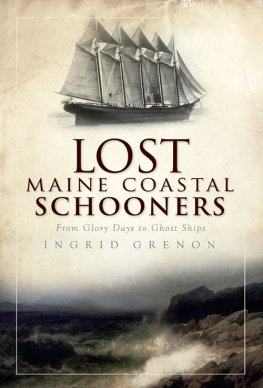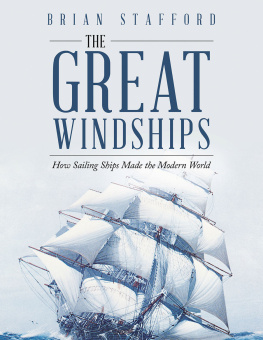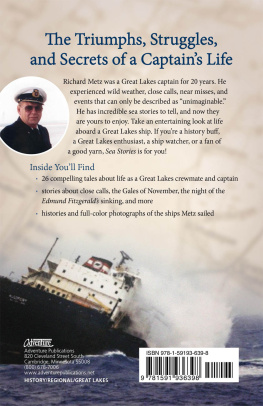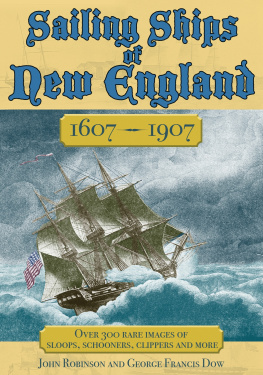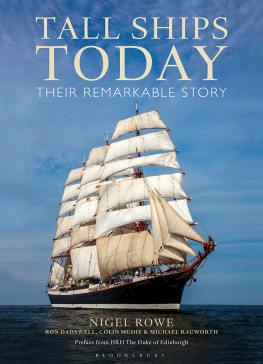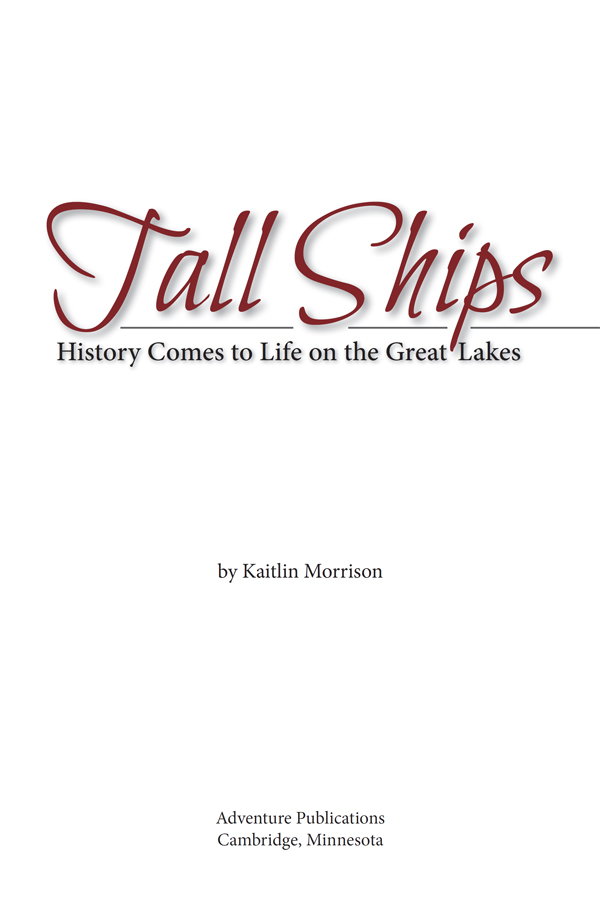
Edited by Brett Ortler
Cover and book design by Lora Westberg
Copyright 2016 by Kaitlin Morrison
Published by Adventure Publications
820 Cleveland Street South
Cambridge, Minnesota 55008
(800) 678-7006
www.adventurepublications.net
All rights reserved
Printed in U.S.A.
ISBN: 978-1-59193-579-7; eISBN: 978-1-59193-613-8
Acknowledgments
Many thanks to the following photographers and organizations; their photographs grace the pages of this book (see for the full ): Aaron Headly, Alan Woodhead, Amy McGovern, Andrew Bone, Scott Ellis and everyone at BaySail, Bob Adams, Boris Kasimov, Christy Griffin and the staff at the Bytown Brigantine/Tall Ships Adventure, Cathy A. Smith, Dan Downing, Dave Foster, Dennis Jarvis, Erin Short at Tall Ships America, the crew of the Fazizi , Darren Wells and the staff of the Great Lakes Schooner Company, Hussein Abdallah, Kathy Tahtinen and the staff of Inland Seas Schoolship, Jeff Thoreson at Erie Shipping News , Jesse Davis, Joanna Poe, Kathleen Maskus/Natural Solitude, Kenneth Newhams at Duluth Shipping News , Lois Bravo, Lyle Vincent, Sherri at the Maritime Heritage Alliance, Martin Cathrae, Michael Greminger, Captain Andrew Sadock and Sam Perkins-Harbin of the Red Witch , Liz Kincheloe-Spain and the Roseway , Scott Colbourne, Scott Proudfoot, Shutterstock, the U.S. Navy, the U.S. Coast Guards excellent photography staff, Will Scullin, and finally Lynn Randall and the crew of the Windy .
are listed.
Dedication
This is for Jeff Greenlund, my best friend and husband.
I want to thank my entire family for supporting me throughout this journeyFirst, my parents, Dr. Paul Morrison, MD and Vicki Morrison for taking me to visit the Great Lakes when I was a kid and for introducing me to the wonderful world of ships.
My sister, Kelsey Morrison and my inlaws, Doug and Marla Greenlund for being constant cheerleaders. My brother-in-law, Joe Greenlund and my grandma, Barbara McDonald for challenging me to be a better person.
Of course, this book couldnt happen without the great team at Adventure Publications. I deeply appreciate my editor, Brett Ortler, for all of his hard work on this project and endless ideas. I thank God for all of the people who contributed to this book and for all of the tall ships that make this book possible.
Table of Contents
Introduction
Whether you see a tall ship breaking over the horizon, or up close at a tall ship festival, theres nothing quite like seeing a full-fledged sailing ship. These majestic vessels are often thought of as ocean-going vessels, but many tall ships ply the waters of the Great Lakes. Some have homeports on the Great Lakes, whereas others are based abroad and only visit the region occasionally, often for tall ship festivals.
Tall ship events are usually held every three years on the Great Lakes; when such events are underway, they never fail to draw tens of thousands of visitors at each port, sometimes even hundreds of thousands. Previous tall ship events were held on the Great Lakes in 2013 and 2010, and all of the vessels in this book participated in one of those events, so this book is a good introduction to the vessels that you may encounter. Of course, this doesnt mean that youll find all of the ships in this book at a port near you; some ships only visit certain Lakes or ports, and schedules can change, equipment can break, and tall ships, perhaps more than any other kind of vessel, are subject to the vagaries of the weather. Running a tall ship is economically precarious, too, so tall ships also change owners relatively often.
The following ships represent a good cross section of the tall ships that youre likely to see on the Great Lakes. Many have homeports on the Great Lakes; those that dont are common fixtures at tall ship festivals. In addition, many of the vessels included are very accessible and open to the public for dockside tours and daysails, and many offer extended sail-training courses for youth and adults. Some can even be chartered for longer trips or events such as weddings, meetings and other private events.
So whether you see the famous Brig Niagara fire off its carronades or witness the majesty of tall ship after tall ship entering the harbor during a parade of sail, get out there and see a tall ship on the Great Lakes. Its an experience youll never forget.
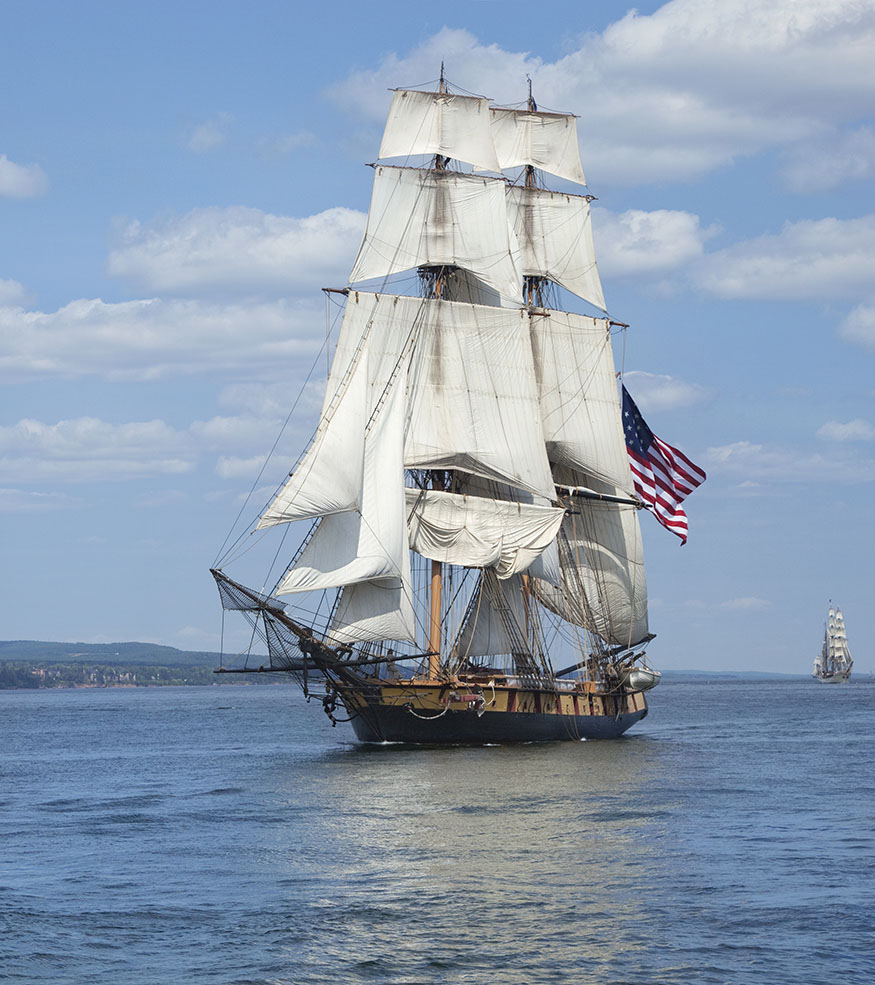
Parts of a Tall Ship
At its core, sailing is a relatively simple concept, but when it comes to sailing terminology, things get confusing in a hurry. Sailing, like most other fields, has its own language; thankfully, the basics arent that hard to understand.
Tall ships are powered by sails, and float because their hull (the body of the ship) displaces water. A ships hull is built around its keel, the ships primary beam/support structure. If youre standing on the deck of a ship, the keel runs on a straight line from the bow (the front) of the vessel to the stern (the back of the boat). If youre standing on a ship, looking to the bow, the direction to your left is known as the port side; the direction to your right is starboard.
A tall ship is propelled largely by its sails, fabric structures that are supported by spars, wooden (or metal) supports that can be either vertical or horizontal. When spars are horizontal, they are known as yards. An angled spar that supports a sail is called a gaff. Vertical spars are known as masts. Masts can have more than one sail, and each additional sail has its own name, though listing each is beyond the scope of this book. Sails are raised/lowered by using halyards (ropes/chains) and controlled by sheets (ropes or chains that manipulate the sail).
Masts and Rigging
On a ship with three masts, the mast at the front of the vessel is called the foremast. The mast at the center of the vessel is the mainmast. If theres a third mast, its called the mizzenmast.
The way a ships sails and its masts are configured is known as its rigging. As you might expect, there are a hundreds of different ways to rig a ship, not to mention a number of different sails (depending on their shape/placement), so well only cover the basics.
Square-rigged sails are rigged perpendicular to the ships keel. To put it in simpler terms, wind pushes on them from one side onlythe backpropelling the vessel forward. Fore-and-aft rigged ships have sails that run parallel to the ships keel, and wind can push on them from either side.
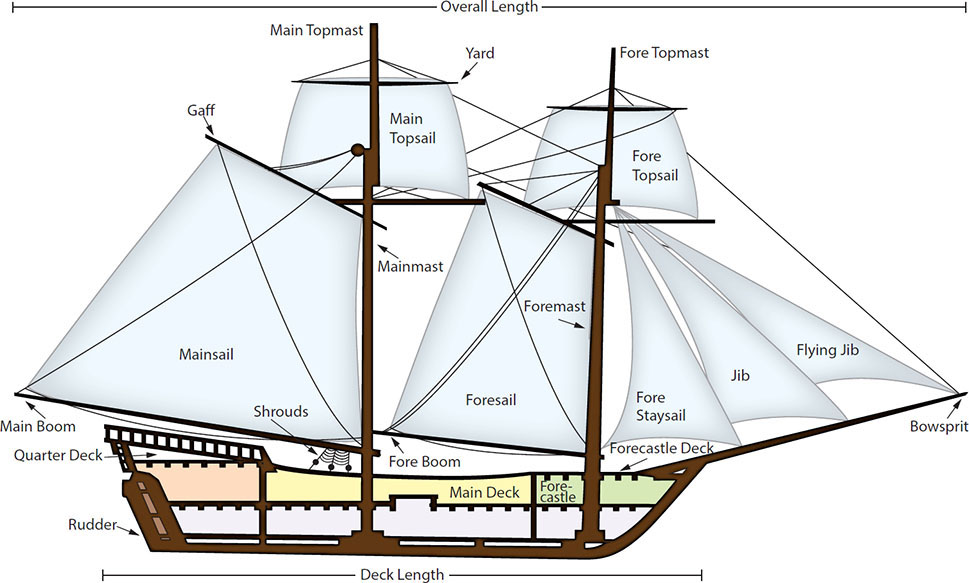

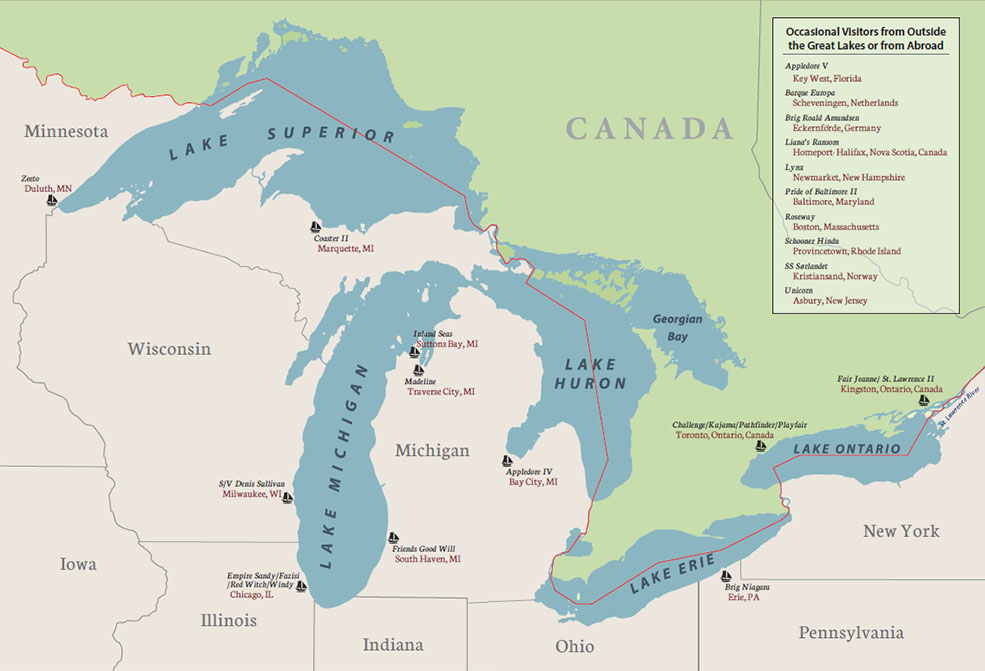
Appledore IV

Appledore IV: Sea Stories
The Appledore IV is a two-masted schooner with a steel hull and features designed to support comfortable, extended travel for her crew and passengers. As the name suggests, the Appledore IV is part of a series of ships, all of which are known as Appledores. The Appledore IV has seen it allit carried her original owners on family travels, has been used as a charter ship, and is used today as a floating classroom. Originally commissioned and built by Herb and Doris Smith, a globe-trotting couple, the Appledore IV has left her home ports in the United States for exotic voyages around the world. The Appledore name is a reference to the island where the couple first saw each other. Doris lived on Appledore Island, Maine, and unknowingly waved at her future husband as he sailed by.



